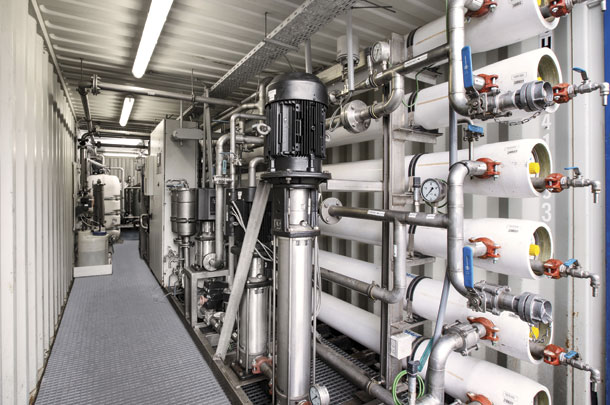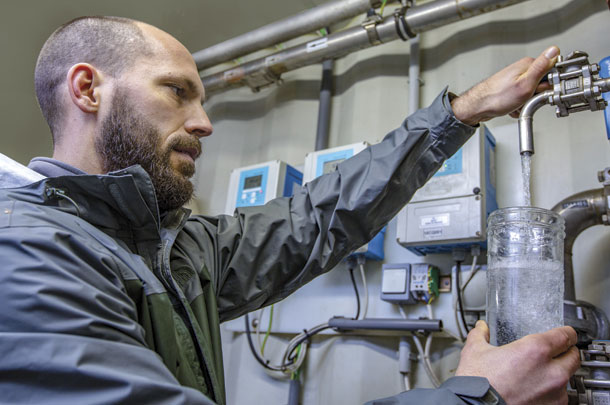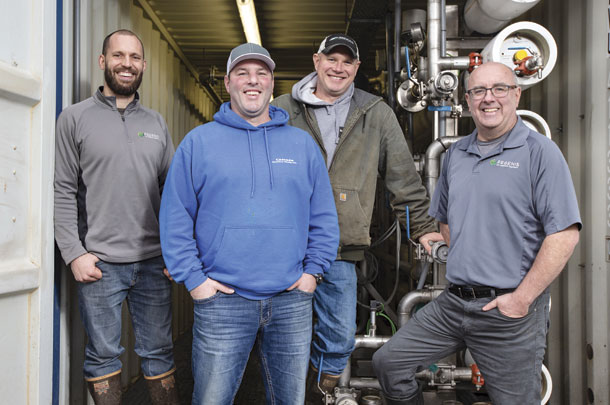With their new 50-stall rotary parlor that has the capacity to milk 2,200 cows three times a day, Smith says their goal is to maximize the use of this new facility. Results from a recent collaboration to remove water from manure look favorable to achieving that goal.
As a pilot program, the Washington State Conservation Commission (WSCC) awarded a $930,305 grant to install and operate a clean-water membrane technology system provided by Regenis, an agricultural waste solutions company. This system will generate 12,000 gallons of clean water daily from the 60,000 gallons of cow manure the farm produces through a unique combination of nano-filtration and reverse osmosis.
Once treated, the water is suitable for farm animals to drink or even to benefit local salmon runs by increasing stream flow.
All the manure at Coldstream is stored in earthen lagoons that are clay-lined, and excess rain can pose a major problem. “In 2018, we received 72 inches of rain, and we are having to store all that rainwater in our lagoon.” Smith continues, “The water table is high here, and our lagoons are built with 2 feet of space above the high-water mark, so we end up collecting 4 or 5 feet of water in a lagoon that has a total height of 12 feet, and that doesn’t leave us much room for manure.”

While Coldstream has plenty of available ground in the area to spread manure, they would like to use the manure more efficiently with a “zero-waste mentality.” Smith says, “Manure is very valuable to us to grow crops, so we are working on making better utilization of it.”
It was perfect timing for the pilot program, as Smith was investigating ways to concentrate manure and eliminate excess water. He penciled out putting covers over the lagoons to cut down on the collection of rainwater, but he found it to be cost-prohibitive. “It was going to cost us about half to three-quarters of a million dollars, and it really didn’t solve the problem,” he says.
Smith continued to search for a solution, vetting different companies and their technology. Through conversations with Regenis, Smith says it was apparent they had a possible solution, and what they offered was definitely feasible, so he proceeded to research the project using their own resources. Smith explains, “We were looking at using all of our own money, but we were blessed the state of Washington wanted to invest financially in dairy technologies.” He notes if dairies are going to stay in Washington state, especially in this market with no extra cash for this kind of project, the state was going to have to help in some way.
“Washington state was tasked with selecting projects, and we were fortunate enough to be selected as a pilot project to show what’s possible with clean-water technology on a dairy,” Smith adds.
The membrane system installed on the dairy this last fall uses a combination of nano-filtration and reverse osmosis to extend membrane life, resulting in lower operational costs as well as producing water clean enough for animals to drink or to use on the farm. Not only will this system reduce lagoon storage needs, but it will allow for increased herd size without a new source of water. It’s a turnkey automated system and is fully remote.
Not only can water from the agricultural water management system be used safely on fields and for on-farm industrial uses, but it’s also approved for farm animal consumption and even meets EPA standards for safe release into nearby streams and rivers.
Eric Powell of Regenis explains the process. “It’s a pre-treatment followed by membrane treatment where we are removing solids and then concentrating nutrients to make clean water, a stackable solid, concentrated nutrients and a liquid with concentrated nutrients.” He continues, “The pre-treatment is a process where an organic polymer is added to bind solids together and remove them to produce a pile of concentrated nutrients and a tea-water liquid to send through the membrane system. The membrane process is a two-step process of nano-filtration and reverse osmosis.”

Powell notes, “One of the benefits of this pre-treatment process is to have a pile of concentrated nutrients easy to move and to apply to fields.” He adds, “We are able to concentrate approximately 80 percent of phosphorus and 35 percent of nitrogen.”
This specific project is intended to be used as a demonstration for others who may be considering this type of nutrient management. In addition, they are working to take that water and put it in the nearby river to use as stream flow augmentation for salmon in the river. Powell adds, “You don’t have to take it that far, and I don’t think that will happen in every application, but with this project, we want to show what is possible.”
Powell says he believes dairy producers need to have options, and this project shows various ways they can use advanced nutrient management. “This is a good tool that needs to be in the toolbox, since environmental regulations are not going away, and dairies need to have options,” he notes.
Different farms require different applications. Powell explains, “There are certain places where this makes a lot more sense. In this case, Coldstream doesn’t have a nutrient problem; they have a water problem. It rains a lot, so this is an opportunity to remove water from the system.” He continues, “Places where dairies have to haul manure long distances, concentrating the nutrients will provide a real benefit.”
In addition, if a farm needs more water for irrigation or for cow drinking water, then this may be an opportunity for them. Powell said there is no silver bullet for everyone; it’s going to be a good solution in certain situations, and others won’t need it.
“This technology had some good research behind it; it was being done successfully in Europe, and we thought it was the real deal and, with the grant, we decided to move forward with it,” Smith adds. In this northwest corner of Washington, natural resource conservation is important. “There are a lot of conservation efforts existing in the area already. During the summer months, we can irrigate most of our land, but at times the river flow can be below what is deemed necessary to maintain a healthy fish population, and adding water from our system can be helpful,” he says. While in the process of testing the water and attaining the permits necessary to discharge into the stream, the farm is holding it in their lagoon.
Smith admits, “We struggle just like everyone else in the industry; 2018 has been one of the toughest years next to 2009, and farmers are eternal optimists, so we always have that mentality.” He continues, “But when we can take a project like this, with measurable results, like lower trucking costs to get nutrients on the fields and getting more manure out in a timely fashion, and use all of our nutrients rather than giving it away because we don’t have storage capacity and, in turn, buying fertilizer at a later date, then it’s a huge win for us.” Smith says they also have the potential of another income stream with selling the solid byproducts.

Powell is looking forward to the end result of this project. “They are a well-run, well-respected dairy and have been a great partner in this project, and we are very thankful,” Powell concludes.
Coldstream Farm LLC is currently milking 1,600 cows with 20 employees, in addition to the family. Jeff and Vickie Rainey started the dairy in 1978 and had three daughters. Galen Smith married the oldest daughter, Laura, and came into the dairy in 2000 and became a partner in 2008.
In 2012, they expanded with the 50-stall rotary parlor and a new barn. Today, Galen is the general manager, Laura does the bookkeeping, sister-in-law Lynne Wheeler does the herd health and mowing, while Galen’s brother, Brad Smith, oversees the nutrient management program, the crops and helps Lynne manage the heifer program. Jeff and Vickie are still involved in a supervisory capacity. ![]()
PHOTO 1: The clean-water membrane technology starts with liquid manure after the solids have been separated. In the pre-treatment step an organic polymer is added to bind solids together. The remaining liquid is sent through a two-step membrane process of nano-filtration followed by reverse osmosis.
PHOTO 2: At Coldstream Farm, scraped manure passes through a separation system. The solids are fed into an in-vessel composter and are then used for bedding. The liquid concentrate is put through a treatment system to filter out fine particles.
PHOTO 3: Eric Powell of Regenis explains they are working to take the clean water from the system and put it in the nearby river to use as stream flow augmentation for salmon in the river.
PHOTO 4: Galen Smith (second from left), general manager at Coldstream Farm LLC., says they had a water problem, not a nutrient problem. To solve this, he is partnering with Regenis on a pilot project using advance nutrient management. Team members from Regenis include, Eric Powell (left), Andy Hanson (second from right) and Dr. Craig Frear (right). Photos courtesy of Regenis.
Melissa Hart is a freelance writer in North Adams, Michigan.






